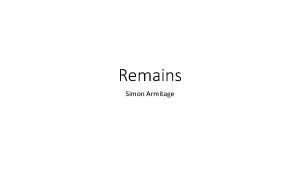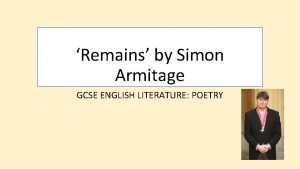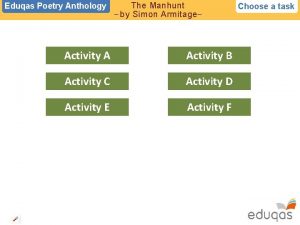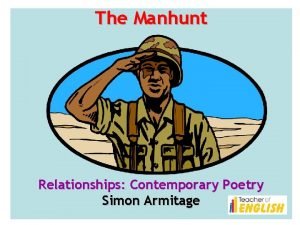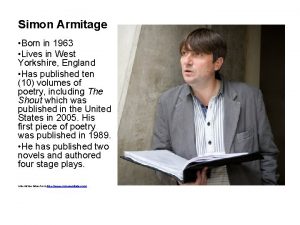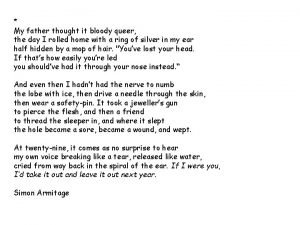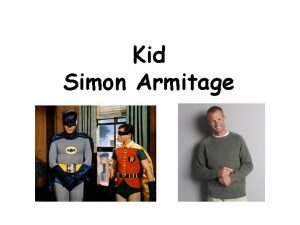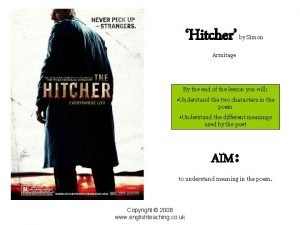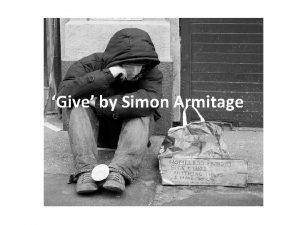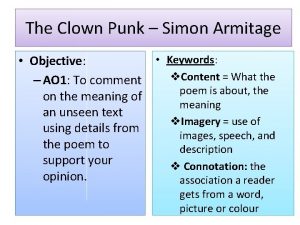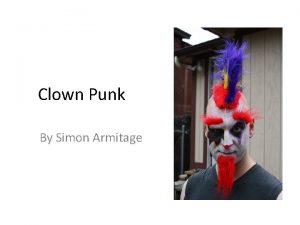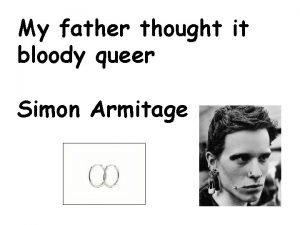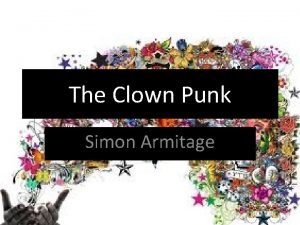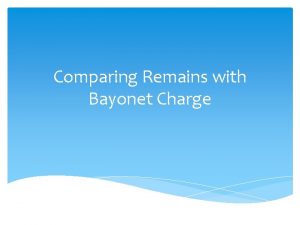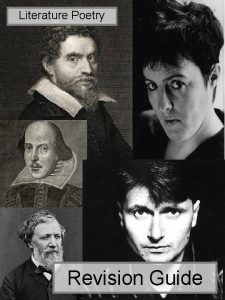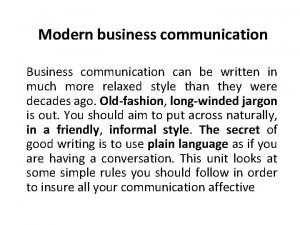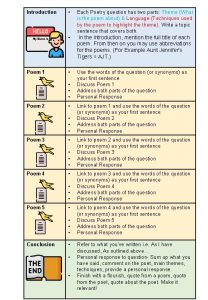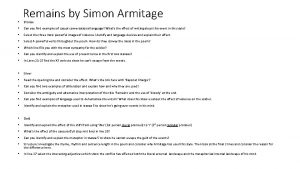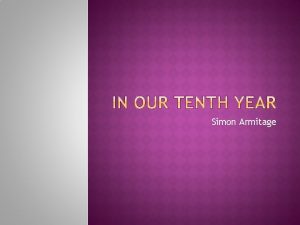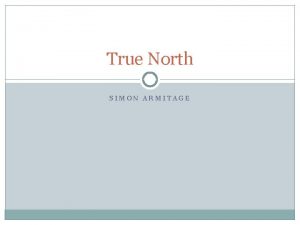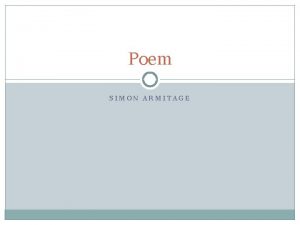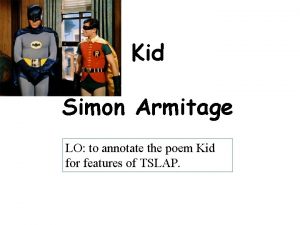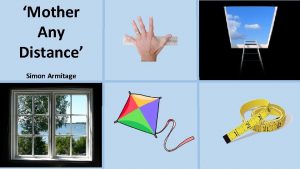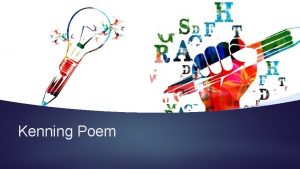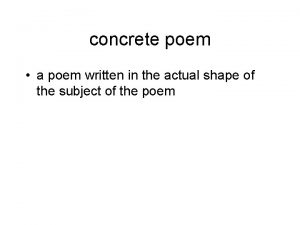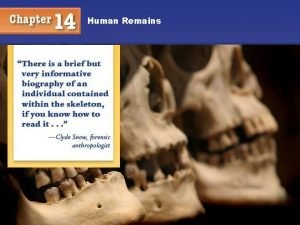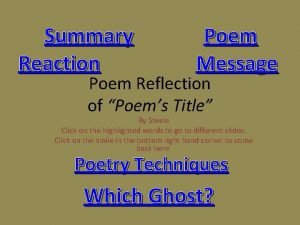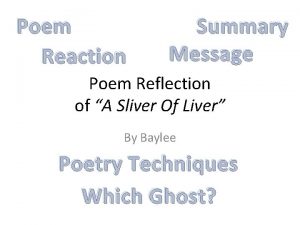Remains Simon Armitage Summary Context Modern poem written





















- Slides: 21

Remains – Simon Armitage Summary + Context Modern poem written by Simon Armitage for the collection “The Not Dead, ” inspired by the stories of soldiers suffering from PTSD who returned home from the Iraq war. Based on the story of Guardsman Tromans, a young man who was interviewed by Armitage. Tells the story of a soldier who, whilst on patrol, kills a looter raiding a bank, who may have been unarmed. When he returns home, he suffers from PTSD, experiencing flashbacks, isolation and feelings of intense guilt, due to blaming himself for the looter’s death. Message • • • Armitage highlights the traumatic effects of war, and demonstrates how it can affect a person way after war has ended Armitage explores the stigmas associated with PTSD, and reveals how many people hide their true situation in order to live up to stereotypes Armitage exposes the graphic and brutal nature of modern conflict Structure • • Armitage uses free verse, enjambment and irregular meter to mirror the soldier’s lack of control over his chaotic and traumatising memories Armitage has organised the poem into regular quatrains (4 line stanzas) to mirror how, on the surface, the soldier tries to appear in control, in order to fulfil society’s stereotype of the “brave solider”, when in reality he is suffering mentally Language 1. 2. 3. 4. 5. The poem begins using the collective pronoun “us” and changes to the singular pronouns of “I” and “my” to demonstrate the soldier’s remorse and self-blame for the death of the looter Metaphor “I see every round as it rips through his life” used to highlight the brutality and graphic nature of war. The word “rips” is usually associated with violent, strong tearing or pulling, demonstrating how violent the death of the soldier is. Metaphor “blood-shadow” – blood is a symbol of guilt, shadows always follow you around, suggesting that the guilt never leaves him. Shadows are also dark, caused by a blocking of light, highlighting how the soldier is now in mental “darkness” and has lost all light and hope from his life. Shadows are also associated with horror and nightmares, suggesting that the soldier is now living in a horrific nightmare. Metaphor “he’s here in my head when I close my eyes/dug in behind enemy lines” – “he’s here” suggests how the memory of the looter is always with him, almost like a ghost haunting him. “When I close my eyes” – he cannot block out the memories of the looter. “Dug” means buried deep, suggesting the looter’s memory is dug deep into his mind and cannot be removed. “Behind enemy lines” – the soldier now sees his own mind as enemy territory – it is a dangerous place that will cause him harm. The soldier also uses the language of war even when home, suggesting how trapped he is in his memories. Metaphor “his bloody life in my bloody hands” – suggests the soldier feels deep responsibility for the death of the looter. “Bloody” – symbol of guilt associated with Macbeth, highlights the soldier’s deep guilt. Lady Macbeth is mad when she imagines blood on her hands, suggesting how the soldier is also being driven mad by his memories. Repetition of “bloody” which is also a mild swear word – the soldier feels anger towards himself. Links to other poems 1. 2. 3. War Photographer – both highlight the long-lasting mental effects of war on individuals, and the feelings of internal conflict associated with this. Poppies – both are about the mental suffering of people back at home, highlighting how conflict causes deep mental suffering beyond the conflict zone itself. Exposure – both highlight the mental suffering that soldiers experience due to the brutal and graphic nature of conflict.

Remains By Simon Armitage On another occasion, we get sent out to tackle looters raiding a bank. And one of them legs it up the road, probably armed, possibly not. Well myself and somebody else are all of the same mind, so all three of us open fire. Three of a kind all letting fly, and I swear I see every round as it rips through his life – I see broad daylight on the other side. So we’ve hit this looter a dozen times and he’s there on the ground, sort of inside out, pain itself, the image of agony. One of my mates goes by and tosses his guts back into his body. Then he’s carted off in the back of a lorry. End of story, except not really. His blood-shadow stays on the street, and out on patrol I walk right over it week after week. Then I’m home on leave. But I blink and he bursts again through the doors of the bank. Sleep, and he’s probably armed, possibly not. Dream, and he’s torn apart by a dozen rounds. And the drink and the drugs won’t flush him out – he’s here in my head when I close my eyes, dug in behind enemy lines, not left for dead in some distant, sun-stunned, sand-smothered land or six-feet-under in desert sand, but near to the knuckle, here and now, his bloody life in my bloody hands.

Remains – Simon Armitage 1. What inspired Armitage to write the poem? 2. What is the story of the poem? 3. What does Armitage expose about war? 4. What does Armitage demonstrate about the effects of war on individuals? 5. How does Armitage hope the reader will feel after reading the poem? 6. List 3 structural features that Armitage uses and their effect 7. Why is the poem organised into regular quatrains? 8. How and why do the pronouns change in the poem? 9. Give a metaphor that Armitage uses to highlight the brutality of war and explain its effect 10. Give a metaphor that Armitage uses to demonstrate the soldier’s feelings and explain its effect

Poppies – Jane Weir Summary + Context Modern poem written by Jane Weir, a mother of teenage sons, written to expose the universal suffering of women during war, which has affected women for generations, in many different cultures. Written from the first person perspective of a mother whose son leaves home for war. The poem describes the anxiety and pain the mother experiences as she is powerless to protect her son. Message • • • Weir exposes how it is not just soldiers who are affected by war, but families too, in particular women, who experience great suffering and pain. Weir highlights how the suffering of women during wartime is a universal idea that has existed in many cultures and time periods. Weir encourages readers to empathise more with the stories of those left behind during war, as well as focusing on soldiers themselves. Structure • Weir uses free verse, irregular meter and enjambment to mirror the mother’s lack of control over her situation, as she powerlessly waits at home. It also may be used to mirror the mother’s overwhelming, painful thoughts and memories that overwhelm her mind. Language • • • Metaphor “Sellotape bandaged around my hand” – bandages are used to heal wounds, symbolising how the mother might be wounded or in pain as her son leaves for war. “Sellotape” is used to hold things together – suggests the mother wants to keep her son stuck to her, but can’t Metaphor “steeled the softening of my face” – the mother has to be strong despite her fears and sadness – “steel” is a hard and cold substance that juxtaposes the “softening” – suggesting the mother has to become hard and cold in order to stop her emotions from coming out Metaphor “gelled blackthorns of your hair” – “gelled” associated with teenagers – highlights the son’s youth and innocence. “Blackthorns” create an image of the Christ-like crown of thorns – the mother sees the son, like Jesus, as an innocent sacrifice. “Blackthorns” also cause pain if touched – suggesting that the mother feels immense pain when saying goodbye to her son. “Blackthorns” are also hard and sharp – highlighting the son’s toughness and determination to go to war in contrast to the mother’s desire to have him at home. Simile “the world overflowing like a treasure chest” – the son is excited to go to war because he sees it as an adventure, like a quest for treasure. Verb “overflowing” suggests how the son sees the world as full of excitement, while “treasure” brings you riches and wonderful things, which is how he sees war. This contrasts the mother’s anxiety to keep him at home. Metaphor “released a song bird from its cage” – the bird could symbolise the son – the mother is letting him “fly the nest” and be free. “Song” symbolises happiness and joy – the mother is releasing all of her happiness and joy as the son has left. Metaphor – “my stomach busy making tucks, darts, pleats” – the mother feels immense pain after her son has left. “Stomach” is a place where often feelings of anxiety are felt strongly. “tucks, darts and pleats” are made when sewing with a needle – as if the mother is being repeatedly stabbed by a needle, highlighting her pain. Links to other poems • • Links well to Remains – both are about the mental suffering of people back at home, highlighting how conflict causes deep mental suffering beyond the conflict zone itself. Links well to My Last Duchess – both are about the powerlessness of women in male-dominated, patriarchal society

Poppies By Jane Weir Three days before Armistice Sunday and poppies had already been placed on individual war graves. Before you left, I pinned one onto your lapel, crimped petals, spasms of paper red, disrupting a blockade of yellow bias binding around your blazer. Sellotape bandaged around my hand, I rounded up as many white cat hairs as I could, smoothed down your shirt's upturned collar, steeled the softening of my face. I wanted to graze my nose across the tip of your nose, play at being Eskimos like we did when you were little. I resisted the impulse to run my fingers through the gelled blackthorns of your hair. All my words flattened, rolled, turned into felt, slowly melting. I was brave, as I walked with you, to the front door, threw it open, the world overflowing like a treasure chest. A split second and you were away, intoxicated. After you'd gone I went into your bedroom, released a song bird from its cage. Later a single dove flew from the pear tree, and this is where it has led me, skirting the church yard walls, my stomach busy making tucks, darts, pleats, hat-less, without a winter coat or reinforcements of scarf, gloves. On reaching the top of the hill I traced the inscriptions on the war memorial, leaned against it like a wishbone. The dove pulled freely against the sky, an ornamental stitch. I listened, hoping to hear your playground voice catching on the wind.

Poppies – Jane Weir 1. What inspired Weir to write the poem? 2. What is the story of the poem? 3. What does Weir expose about war? 4. What does Weir demonstrate about the effects of war on individuals? 5. List 3 structural features that Weir uses and their effect 6. What is the effect of the metaphor “Sellotape bandaged around my hand”? 7. What is the effect of the metaphor “steeled the softening of my face”? 8. Why might Weir focus on the “gelled blackthorns” of the son’s hair? 9. What is the effect of the simile “the world overflowing like a treasure chest”? 10. What is the effect of the metaphor “released a song bird from its cage”?

Summary + Context War Photographer – Carol Ann Duffy Modern poem written by Carol Ann Duffy. Focuses on a war photographer who is back home, developing photographs that he has taken in war. He tries to detach himself from the photos, seeing it as his “job”, but is haunted by the strong memories he has of war. He feels resentful at the apathy of the British public who “do not care” about the suffering of the people in war, as they flick carelessly from his photographs to having a “bath” and “beers” Message • • • Duffy exposes the brutality and violence of modern warfare, and the horrific suffering of people in warzones Duffy criticises the apathy felt by the Western World as we pay little attention to the suffering of people in warzones Duffy encourages readers to feel more empathy and care more deeply about the suffering of those in war Structure • • Duffy uses regular rhyme scheme and organises the poem into regular sestets to mirror how the war photographer tries to detach himself from the chaos of the photographs and his memories Duffy uses an irregular meter to reflect how, beneath the surface, the photographer’s memories overwhelm him and haunt him Language • • • The image of the “ordered rows” of the photographs symbolises how the photographer attempts to detach himself from the chaos of his memories by organising them and ordering them Metaphor “spools of suffering” highlights the immense amount of suffering the war photographer has witnessed in war. A “spool” is a long roll of film, symbolising the long days of suffering he has seen. The use of sibilance here is uses to highlight the sinister and evil nature of war, as s-sounds are often associated with serpents, a symbol of evil. Juxtaposition between England the warzones is used. England is “rural” which is associated with peace and safety. It has “ordinary pain” suggesting that the suffering that happens in England is actually meaningless. This contrasts to the “running children in a nightmare heat” that symbolises warzones. “children” are innocent and vulnerable. The verb “running” highlights their desperation to escape, and their panic. The “nightmare heat” sounds monstrous and hellish, suggesting that warzones are places of evil. Metaphor “a half-formed ghost” – the photographer is haunted by the memories of the people he has seen in conflict, as ghosts come back from the dead to haunt the world. This highlights the photographer’s guilt. Symbolism “the blood stained into foreign dust”. Blood is a symbol of guilt, suggesting that the photographer feels guilt and remorse due to being powerless to stop the suffering of people in war. A “stain” is hard to remove, suggesting that the photographer’s guilt is permanent and his mind is scarred by the memories. Image of complacency “the reader’s eyes prick with tears between the bath and pre-lunch beers”. – this image is focused on to show the Western World have become desensitised – we are so used to seeing images of war that we no longer care. The word “prick” is associated with a pin-prick – a tiny stab of pain that lasts for no longer than a second – suggesting that the feelings we feel about conflict do not last. “Baths” and “beers” are associated with relaxation and luxury – we care more about ourselves than those in war. Links to other poems • Links well to Remains – both are about the mental suffering of people back at home, highlighting how conflict causes deep mental suffering beyond the conflict zone itself.

War Photographer By Carol Ann Duffy In his dark room he is finally alone with spools of suffering set out in ordered rows. The only light is red and softly glows, as though this were a church and he a priest preparing to intone a Mass. Belfast. Beirut. Phnom Penh. All flesh is grass. He has a job to do. Solutions slop in trays beneath his hands, which did not tremble then though seem to now. Rural England. Home again to ordinary pain which simple weather can dispel, to fields which don’t explode beneath the feet of running children in a nightmare heat. Something is happening. A stranger’s features faintly start to twist before his eyes, a half-formed ghost. He remembers the cries of this man’s wife, how he sought approval without words to do what someone must and how the blood stained into foreign dust. A hundred agonies in black and white from which his editor will pick out five or six for Sunday’s supplement. The reader’s eyeballs prick with tears between the bath and pre-lunch beers. From the aeroplane he stares impassively at where he earns his living and they do not care.

War Photographer – Carol Ann Duffy 1. What is the story of the poem? 2. What does Duffy expose about war? 3. What does Duffy criticise? 4. What does Duffy encourage readers to do and why? 5. Why does Duffy use a regular rhyme scheme and divide the poem into regular quatrains? 6. Why might Duffy use an irregular meter? 7. What is the effect of the metaphor “spools of suffering set out in ordered rows”? 8. What imagery does Duffy juxtapose in the poem? 9. What is the effect of the metaphor “a half-formed ghost”? 10. What is the effect of the line “blood stained into foreign dust”?

Bayonet Charge – Ted Hughes Summary + Context Twentieth century poem written by Ted Hughes from the collection “The Hawk in the Rain” which is about the impact of war on the natural world, and inspired by the events of WW 1. Tells the story of a soldier who is part of a bayonet attack. As the soldier runs for cover, he loses his sense of patriotism and honour that he has been told by propaganda. He instead focuses purely on survival, and is driven by fear. Message • • • Hughes exposes the true brutal and chaotic reality of conflict, and how it causes soldiers to feel extreme fear and distress Hughes criticises the use of propaganda by governments in war, suggesting how it manipulates soldiers into going to war for patriotic reasons Hughes highlights the devastating impact on the natural environment that war can have, highlighting how, like innocent soldiers, nature is an innocent victim of war Structure • • Free verse, and enjambment are used to mirror the chaos of war, and the soldier’s chaotic and overwhelming feelings of fear and distress The poem begins in medias res, highlighting the constant and overwhelming stress that soldiers face in war Language • • • Metaphor – “bullets smacking the belly out of the air” symbolises the brutal and destructive nature of war. “Smacking” is a harsh, painful movement often associated with violent parents who hurt innocent children, suggesting that the air (nature) is an innocent victim of war. The repeated plosive “b” sounds create a harsh and heavy sound, symbolising the loud and overwhelming sounds of war. The “belly” is a soft and vulnerable part of the body, which if hit can cause serious injury to a human, showing how dangerous war is. Furthermore, “bellies” are often associated with pregnant mothers who hold innocent children in their wombs – suggesting that war destroys life. Simile – “the patriotic tear that had brimmed in his eye / sweating like molten iron from the centre of his chest, ” – the soldier’s patriotism is now leaving his mind and body as he realises the harsh reality of war. The “centre of the chest” is the heart, associated with feelings and emotion – he is now losing all feelings of patriotism and honour from his heart. Metaphor “in what cold clockwork of the star and the nations was he the hand pointing at that second? ” – the soldier imagines himself as a hand on a clockface – he is just one small part of the “clockwork” of war, created by the “stars and the nations” (governments and world leaders), and realises that his life does not truly matter to these people. The word “cold” highlights how governments are cold and do not genuinely care about their soldiers. This is emphasised by the harsh alliteration of the “c” and “k” sounds which mirror the brutality of war. Natural imagery of the “yellow hare” that is killed, its mouth “open silent” – the hare can be a symbol of innocence – it is an innocent victim of war that, even though it is screaming, cannot be heard. The hare could symbolise the many innocent soldiers and people that lose their lives in war. “Hares” are also an ancient symbol of the circle of life – the fact that the hare is killed suggests that war causes the circle of life to be destroyed, which is unnatural. Simile – “King, honour, human dignity, etcetera, dropped like luxuries in a yelling alarm” – the soldier forgets all of the messages he has been told by propaganda as he realises that war is not an honourable and exciting place, but a fearful place where he needs just to survive. The word “etcetera” which is used to describe something unimportant, highlights how these big ideas are actually meaningless. He sees them as “luxuries” which are not needed. Links to other poems • • Links well to Remains and War Photographer – both poems highlight the traumatic effects of war, and its brutality and violence Links well to Charge of the Light Brigade – both poems are about the issue of patriotism; while the soldiers in COTLB remain patriotic throughout, the soldier in this poem quickly loses his patriotism when faced with the brutality of modern warfare

Bayonet Charge Was he the hand pointing that second? He was running By Ted Hughes Like a man who has jumped up in the dark and runs Listening between his footfalls for the reason Suddenly he awoke and was running – raw Of his still running, and his foot hung like In raw-seamed hot khaki, his sweat heavy, Statuary in mid-stride. Then the shot-slashed furrows Stumbling across a field of clods towards a green hedge That dazzled with rifle fire, hearing Threw up a yellow hare that rolled like a flame Bullets smacking the belly out of the air – And crawled in a threshing circle, its mouth wide He lugged a rifle numb as a smashed arm; Open silent, its eyes standing out. The patriotic tear that had brimmed in his eye He plunged past with his bayonet toward the green hedge, Sweating like molten iron from the centre of his chest, – King, honour, human dignity, etcetera Dropped like luxuries in a yelling alarm In bewilderment then he almost stopped – To get out of that blue crackling air In what cold clockwork of the stars and the nations His terror’s touchy dynamite.

Bayonet Charge – Ted Hughes 1. Which conflict inspired Hughes to write the poem? 2. What story does the poem tell? 3. What does Hughes expose and highlight about war and its impact on soldiers and nature? 4. What does Hughes criticise and why? 5. List 2 structural features that Hughes uses and their effect 6. What is the effect of the metaphor “bullets smacking the belly out of the air”? 7. What is the effect of the simile “the patriotic tear that had brimmed in his eye, sweating like molten iron out the centre of his chest” 8. What is the effect of the Metaphor “in what cold clockwork of the star and the nations was he the hand pointing at that second? ” 9. Explain Hughes’ use of natural imagery and what it represents 10. What is the effect of the simile “King, honour, human dignity, etcetera, dropped like luxuries in a yelling alarm”?

Exposure – Wilfred Owen Summary + Context WW 1 poem written by Wilfred Owen, a soldier in the trenches who died in 1918. He believed it was his duty to tell the truth about war, as the news from the war was censored so that the British public did not hear the awful truth. Written from the perspective of a group of soldiers who suffer due to the brutal conditions experienced in the trenches. They feel hopeless and a sense of pointlessness as they wait endlessly. Message • • • Owen exposes the brutal truth of trench life, which he believed was his duty as he saw how news from the front line during WW 1 was censored and hidden from the British public Owen highlights how nature is a powerful and destructive force over humans Owen reveals the intense mental suffering that soldiers on the front line experienced, due to the brutal conditions experienced in conflict Structure • • • Language The poem is written in cinquains (5 line stanzas) which are an uncommon length of stanza, as they sound uneven and unfinished. The poem is written using a regular pattern of slant rhyme, with words that have similar, but not identical sounds. This creates an uncomfortable and jarring sound in the reader’s ear, as they expect rhyme, but do not quite get it. This mirrors the uncomfortable and painful experience of war. Each stanza ends in a thorn line, which is a short line that does not fit in with the rest of the stanza. This adds to the uncomfortable sound of the poem, emphasising the soldiers’ lack of comfort. • • Extended metaphor of the weather as a personified enemy – the weather is depicted as the enemy of the soldiers as it “attacks” and “knifes” them with its “army” of “mad gusts”, “rain” and “clouds” – this highlights the brutality of trench life and suggests that, in war, the soldiers had to almost fight two wars – one against the Germans, and the other against nature. Repetition of the refrain “but nothing happens” – highlights the endless passive suffering of the soldiers – even though they are not fighting they are exposed to the lethal danger presented by nature. This also highlights the pointlessness of war. Metaphor of the soldier’s “home” with “sunk fires” – a famous song called “Keep the Home Fires Burning” was sung during WW 1 to show how, back in Britain, people still warmly cared for the soldiers. The fact that the “home” the soldiers return to has no fires, suggests that for many soldiers there will be no return to warmth or home, and as a result, songs like this are meaningless. Metaphor “on us the doors are closed” – the soldiers have been shut out from safety and home, suggesting how they have been abandoned. “Doors” symbolise hope and options (e. g the phrase “one door closes, another one opens”). The fact that all doors are shut for the soldiers suggests that they have no hope, and are powerless without any option but suffering. Links to other poems • • Links well to Bayonet Charge - both poems expose the reality of war and how, in war, ideas that soldiers have been told in propaganda become meaningless as they realise the brutal truth of what conflict is like Links well to Remains – both highlight the mental suffering that soldiers experience due to the brutal and graphic nature of conflict.

Exposure By Wilfred Owen Our brains ache, in the merciless iced east winds that knife us. . . Wearied we keep awake because the night is silent. . . Low drooping flares confuse our memory of the salient. . . Worried by silence, sentries whisper, curious, nervous, But nothing happens. Watching, we hear the mad gusts tugging on the wire. Like twitching agonies of men among its brambles. Northward incessantly, the flickering gunnery rumbles, Far off, like a dull rumour of some other war. What are we doing here? The poignant misery of dawn begins to grow. . . We only know war lasts, rain soaks, and clouds sag stormy. Dawn massing in the east her melancholy army Attacks once more in ranks on shivering ranks of gray, But nothing happens. Sudden successive flights of bullets streak the silence. Less deadly than the air that shudders black with snow, With sidelong flowing flakes that flock, pause and renew, We watch them wandering up and down the wind's nonchalance, But nothing happens. Pale flakes with lingering stealth come feeling for our faces-We cringe in holes, back on forgotten dreams, and stare, snow-dazed, Deep into grassier ditches. So we drowse, sun-dozed, Littered with blossoms trickling where the blackbird fusses. Is it that we are dying? Slowly our ghosts drag home: glimpsing the sunk fires glozed With crusted dark-red jewels; crickets jingle there; For hours the innocent mice rejoice: the house is theirs; Shutters and doors all closed: on us the doors are closed-We turn back to our dying. Since we believe not otherwise can kind fires burn; Now ever suns smile true on child, or field, or fruit. For God's invincible spring our love is made afraid; Therefore, not loath, we lie out here; therefore were born, For love of God seems dying. To-night, His frost will fasten on this mud and us, Shrivelling many hands and puckering foreheads crisp. The burying-party, picks and shovels in their shaking grasp, Pause over half-known faces. All their eyes are ice, But nothing happens.

Exposure – Wilfred Owen 1. Which conflict inspired Owen to write the poem? 2. What did Owen believe his duty was and why? 3. What story does the poem tell? 4. What does Owen expose about war and its impact on soldiers? 5. What does Owen criticise and why? 6. List 3 structural features that Hughes uses and their effect 7. What is personified in the poem and how? 8. Give an example of a refrain used in the poem and explain its effect 9. Why might Hughes focus on the “sunk fires” in the poem? 10. What is the effect of the metaphor “on us the doors are closed”?

Summary + Context The Charge of the Light Brigade – Alfred Lord Tennyson Victorian poem about the battle of Balaclava in the Crimean War. Describes the story of the British Light Brigade who were violently killed by the Russian forces, who had canons opposed to the British soldier’s sabres and horses, because of a blunder that Lord Cardigan made after changing the brigade’s order last minute to a full frontal assault. The poem praises the bravery and honour of the soldiers and has a very patriotic tone, due to the fact that Tennson was poet laureate, and his duty was to inspire people to feel proud of Britain, rather than critical. Message • • • Tennyson exposes the chaotic and brutal nature of warfare Tennyson praises the bravery and honour of the light brigade due to their obedience and loyalty to their country Tennyson highlights the devastating impact a leader’s actions can have on the powerless people that they command Structure • • Tennyson uses an irregular rhyme scheme to mirror the chaos and confusion of battle Tennyson uses regular dactylic meter to mirror the relentless forward movement of the light brigade, who did not stop despite the overwhelming danger they faced Language • • • Refrain “six hundred” repeated throughout the poem to continually remind the reader of the soldiers and their sacrifice Anaphora “canon. . canon… canon” highlights how the light brigade were surrounded and trapped, but did not show fear Biblical Metaphors “jaws of death” and “mouth of hell” depict the extreme danger that the soldiers faced. They come from the famous biblical psalm “even though I walk through the valley of death, I fear no evil, ” which highlights the god-like goodness of the light brigade. “Jaws” are vicious, painful things to be trapped in. “Mouth” suggests that the soldiers were almost being swallowed by danger. Repetition of verb “flash’d” – highlights the soldier’s almost god-like natures – their swords shine and dazzle like angelic beings, suggesting that they are almost like holy warriors. Imperative verbs repeated “honour … honour…”command the reader to remember the soldiers’ sacrifice and bravery for eternity. Tennyson does not mention the mistake of Lord Cardigan, instead focusing on the soldiers. This is because he was poet laureate and his duty was to make people feel patriotic, not critical of Britain. Links to other poems • • Links well with Kamikaze – both groups of soldiers feel a strong sense of duty and honour to their country Links well with Bayonet Charge – both highlight the chaotic and brutal nature of war.

The Charge of the Light Brigade By Alfred Lord Tennyson HALF a league, half a league, Half a league onward, All in the valley of Death Rode the six hundred. 'Forward, the Light Brigade! Charge for the guns! ' he said: Into the valley of Death Rode the six hundred. 'Forward, the Light Brigade! ' Was there a man dismay'd? Not tho' the soldier knew Some one had blunder'd: Their's not to make reply, Their's not to reason why, Their's but to do and die: Into the valley of Death Rode the six hundred. Cannon to right of them, Cannon to left of them, Cannon in front of them Volley'd and thunder'd; Storm'd at with shot and shell, Boldly they rode and well, Into the jaws of Death, Into the mouth of Hell Rode the six hundred. . Flash'd all their sabres bare, Flash'd as they turn'd in air Sabring the gunners there, Charging an army, while All the world wonder'd: Plunged in the battery-smoke Right thro' the line they broke; Cossack and Russian Reel'd from the sabre-stroke Shatter'd and sunder'd. Then they rode back, but not Not the six hundred. Cannon to right of them, Cannon to left of them, Cannon behind them Volley'd and thunder'd; Storm'd at with shot and shell, While horse and hero fell, They that had fought so well Came thro' the jaws of Death, Back from the mouth of Hell, All that was left of them, Left of six hundred. When can their glory fade? O the wild charge they made! All the world wonder'd. Honour the charge they made! Honour the Light Brigade, Noble six hundred!

The Charge of the Light Brigade – Alfred Lord Tennyson 1. Which conflict inspired Tennyson to write the poem? 2. What tone does the poem have and why might this be, linking to what you know about Tennyson? 3. What story does the poem tell? 4. What does Tennsyon expose about war and its impact on soldiers? 5. What does Tennyson praise and why? 6. List 2 structural features that Hughes uses and their effect 7. Give an example of a refrain used in the poem and explain its effect 8. Give an example of anaphora used in the poem and explain its effect 9. Give an example of biblical metaphors used in the poem and explain their effect 10. Why might Tennyson repeat the word “flash’d”? 11. Give an example of imperative verbs used in the poem and explain their effect

Kamikaze – Beatrice Garland Summary + Context Modern poem that tells the story of a Japanese kamikaze pilot. Kamikaze is an ancient tradition that comes from the Japanese idea of sacrifice being the most honourable thing a person can do for their community. In WW 2, Japanese propaganda indoctrinated young men to go and blow themselves up in small planes to destroy enemy warships. In the poem, the kamikaze pilot’s mind is conflicted between his public duty of honour and his private duty to his family, and eventually he turns back mid-way through his mission, choosing life with all its richness and beauty (the sea, nature, his family, his memories). This is seen as shameful, and he is shunned by his family. Message • • Garland exposes the power propaganda has on an individual, and explores how it can pressure or brainwash people into committing awful acts in the name of their country and honour Garland highlights the damaging impact of propaganda on soldiers and their private family lives, as they sacrifice their own personal duties to fulfil their public duties Structure • • Garland uses enjambment, free verse and irregular meter to highlight the pilot’s confusion and conflicted mind Garland uses the voice of the pilot’s daughter to tell the story, to highlight the damaging impact that war can have for generations Language • • • Symbol of a “sunrise” (Japanese samurai flag) and the “samurai sword” – symbols of Japanese samurai culture, used to highlight the pilot’s strong belief in samurai culture Metaphor “a shaven head full of powerful incantations” – the pilot has a “shaven head” which could be used to demonstrate his harsh and cruel intentions at the start, as this is usually associated with warriors and fighters. “Incantations” are spells – it is almost as if Japanese culture has cast a spell over the pilot’s mind through propaganda, bewitching him into committing the awful act of suicide Metaphor “he must have looked down” – when the pilot looks down from his plane, it is almost as if he is also looking down into his soul, perhaps “down” future generations to consider the impact of his actions on his private life Simile “little fishing boats strung out like bunting” – seeing this reminds the soldier of his memories and family, causing him to turn back and not commit the mission. “Little” has connotations of fragility and innocence. “Bunting” is flags used at children’s parties – he does not want to be responsible for killing innocent people. Colour imagery “Green-blue translucent sea” – “translucent” symbolises how the pilot might be seeing clearly now. “Green” and “blue” are peaceful, tranquil colours, which symbolise how the pilot is turning towards peace “We too learned to be silent” – the pilot is shunned by his family who feel shame over his actions. This highlights the devastating impact propaganda and war can have on families. “Silent” has connotations of stillness and death; it is almost as if the soldier dies when he returns home. Links to other poems • • Links well with Charge of the Light Brigade – both contain soldiers who have strong senses of honour and duty Links well with Bayonet Charge – both contain soldiers who see the truth of propaganda and turn away from their sense of patriotism and duty

Kamikaze By Beatrice Garland Her father embarked at sunrise with a flask of water, a samurai sword in the cockpit, a shaven head full of powerful incantations and enough fuel for a one-way journey into history but half way there, she thought, recounting it later to her children, he must have looked far down at the little fishing boats strung out like bunting on a green-blue translucent sea and beneath them, arcing in swathes like a huge flag waved first one way then the other in a figure of eight, the dark shoals of fishes flashing silver as their bellies swivelled towards the sun and remembered how he and his brothers waiting on the shore built cairns of pearl-grey pebbles to see whose withstood longest the turbulent inrush of breakers bringing their father’s boat safe yes, grandfather’s boat – safe to the shore, salt-sodden, awash with cloud-marked mackerel, black crabs, feathery prawns, the loose silver of whitebait and once a tuna, the dark prince, muscular, dangerous. And though he came back my mother never spoke again in his presence, nor did she meet his eyes and the neighbours too, they treated him as though he no longer existed, only we children still chattered and laughed till gradually we too learned to be silent, to live as though he had never returned, that this was no longer the father we loved. And sometimes, she said, he must have wondered which had been the better way to die.

Kamikaze – Beatrice Garland 1. Which conflict inspired Garland to write the poem? 2. What story does the poem tell? 3. What does Garland expose? 4. What does Garland highlight? 5. List 3 structural features that Garland uses and their effect 6. Why might Garland include the “sunrise” and the “samurai sword”? 7. Explain the effect of the metaphor “a shaven head full of powerful incantations” 8. Explain the effect of the imagery of the “little fishing boats strung out like bunting” 9. Explain the effect of the colour imagery “green-blue translucent sea” 10. Give an example of the quote “we too learned to be silent”
 Probably armed possibly not
Probably armed possibly not I see every round as it rips through his life
I see every round as it rips through his life Simon armitage gcse
Simon armitage gcse Manhunt simon armitage
Manhunt simon armitage The manhunt simon armitage
The manhunt simon armitage Simon armitage facts
Simon armitage facts My father thought it analysis
My father thought it analysis Kid simon armitage
Kid simon armitage Hitcher by simon armitage
Hitcher by simon armitage Give by simon armitage analysis
Give by simon armitage analysis Clown punk poem
Clown punk poem Simon armitage the clown punk
Simon armitage the clown punk My father thought it poem
My father thought it poem The clown punk simon armitage
The clown punk simon armitage When was bayonet charge written
When was bayonet charge written Remains poem
Remains poem Nonagist
Nonagist High context vs low context culture ppt
High context vs low context culture ppt Social deixis examples
Social deixis examples Komunikasi verbal adalah
Komunikasi verbal adalah Modern business letters are usually written in
Modern business letters are usually written in Money is our madness our vast
Money is our madness our vast
